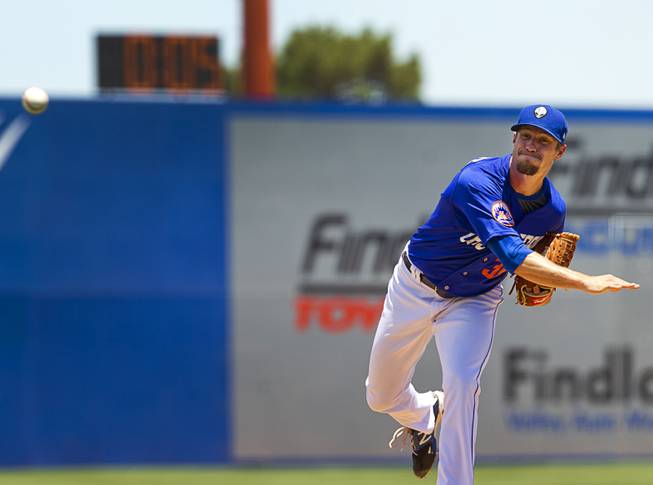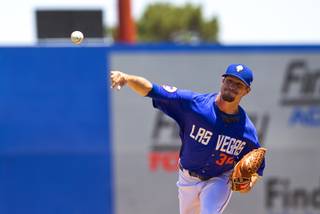
Las Vegas 51’s Logan Verrett warms up as the 51’s play against the Reno Aces at Cashman Field Sunday, June 14, 2015. The clock, top left, counts down the time until the next inning.
Tuesday, June 16, 2015 | 2 a.m.
More Coverage
Spending a summer afternoon at the baseball park is an American tradition. With a ballpark frank in one hand and a mitt on the other, the time can fly by.
But this year, Major League Baseball has implemented some rules to the minor leagues that have helped the games fly by even faster.
The Las Vegas 51s, and the rest of Double and Triple-A baseball, have become the guinea pigs for the MLB, testing a 20-second pitch clock in an attempt to speed up the pace of play. Pitchers must begin their windup within 20 seconds of the previous pitch or an automatic ball is awarded to the batter.
MLB reached an agreement with the minor leagues to install pitch clocks into 60 ballparks, including at Cashman Field.
On the surface the experiment appears to be a success through 59 games. The average 51s game has lasted 32 minutes less than last year’s games — 2 hours, 35 minutes down from 3:07. And only 24 percent of the games have reached three hours, opposed to 68 percent in 2014.
But 51s manager Wally Backman feels the briskness of this year’s games should be attributed to better pitching, and not the pitch clock. Rarely have pitch-clock violations been called.
“Yes we’ve played some fast games this year, but we’ve also had some really good pitching,” Backman said. “(The clock) is really having no effect on the game. I think that we’ve had two or three calls against us in the course of the year so far.”
The numbers support Backman: After leading the Pacific Coast League in scoring last year with 6.11 runs scored per game, the 51s have averaged only 5.21 runs this year. Their pitchers have also dropped their earned run average ERA from 4.64 in 2014 to 4.16 in 2015.
Backman says that while they discussed the rule changes during spring training, Las Vegas pitchers are following the same routine they always have.
“Personally it really doesn’t affect me too much, just because I’ve always been one who works a bit quicker out there,” 51s pitcher Darin Gorski said. “It’s in the back of your head definitely, but it’s just second nature now.”
Gorski admits there are situations where the pitch clock can put stress on the pitcher.
“When the clock is winding down and there’s a guy on second, and you have to do some different things with your signs to the catcher,” Gorski said. “If you rush to get something done you might not put as much thought into what you’re going to throw, and it can play with your head a little bit.”
The batters in the on-deck circle may be the players most affected by the rule change. In between innings, players have 2 minutes, 25 seconds before the next at bat. If they aren’t in position with 20 seconds to go, they will start the at-bat down in the count, 0-1.
“If you are leading off, and you’re running in from defense and the pitcher is already ready, that’s the only thing that gets you sometimes,” 51s first baseman Brandon Allen said.
Three clocks are installed at Cashman Field — one mounted on the outfield wall, and two on the backstop behind home plate.
“I never look at the clock unless I’m leading off the inning. I’ll take a look to see how much time is left so I can hurry up or take my time,” Allen said. “But when I’m hitting during the at-bat, I don’t pay any attention to it.”
Backman feels the clocks have done nothing but make things tougher on the umpires.
“It’s just complicated the game a little bit more, especially for the umpires,” Backman said. “They’ve got enough to worry about other than watching the clock.”
He also says that the rules can be worked around. The pitcher can always step off the rubber if the clock is winding down, and managers can still implement their usual ways of slowing down the game.
“Late in the game, the game speeds up on guys, and you have to be able to control it for certain individuals,” Backman said. “As a manager you’re going to slow things down if you have to. If it means visits to the mound, or having your catcher visit the pitcher.”
Despite Backman’s feelings, don’t expect these clocks to go away anytime soon. With the money invested in minor league parks already, the rules could be implemented into the MLB as soon as next year.
This isn’t the first time rules have been tested on minor leagues prior to introducing it to the big leagues. HGH testing was done at lower levels for three years before the major leagues agreed to it, and Rawlings tried out bulky versions of their Pro Comp carbon fiber helmets for three years prior to bringing them to the MLB.
The pitch clock rule, created to speed up the pace of the game with hopes of attracting more viewers, hasn’t necessarily sat well with baseball veterans.
“I don’t know how it will boost popularity. I guess it gives the fans something else to yell at,” Backman said. “The best thing about baseball was there never was a clock on it.”


Join the Discussion:
Check this out for a full explanation of our conversion to the LiveFyre commenting system and instructions on how to sign up for an account.
Full comments policy